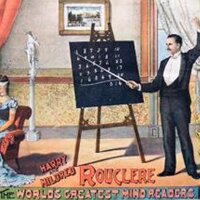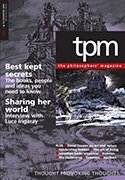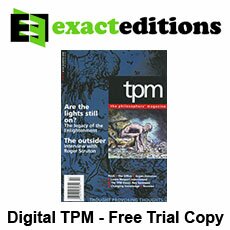Wendy Grossman finds that the dramatic dice are loaded against skeptics
 One of the problems skeptics have is that the “other side” is so much more entertaining than we are. We of course have immaculately good taste and a terrific sense of humour, but when it comes to mounting a great show with singing, dancing, and audience participation, most of the time we’re not so much. I learned this the hard way, by going to a 1994 live appearance at Earl’s Court by the American evangelist and faith healer Maurice Cerullo. The biggest surprise wasn’t the shameless and persistent urgings for money and the buckets everywhere to collect same, or even the shameless and persistent promises that donating money would keep the audience’s families intact and their children safe. It was the sheer showbizness of it all. We just don’t measure up, even those of us with a background in stage magic.
One of the problems skeptics have is that the “other side” is so much more entertaining than we are. We of course have immaculately good taste and a terrific sense of humour, but when it comes to mounting a great show with singing, dancing, and audience participation, most of the time we’re not so much. I learned this the hard way, by going to a 1994 live appearance at Earl’s Court by the American evangelist and faith healer Maurice Cerullo. The biggest surprise wasn’t the shameless and persistent urgings for money and the buckets everywhere to collect same, or even the shameless and persistent promises that donating money would keep the audience’s families intact and their children safe. It was the sheer showbizness of it all. We just don’t measure up, even those of us with a background in stage magic.
I was thinking about this the other day when I read that one of the skeptics – the Skepchick Emma-Louise Rhodes – had written and was producing and starring in a skeptical play. Given that it isn’t much fun for an audience if the characters stand around lecturing each other … then, what?
I also wondered how she’d get around those pesky but unwritten rules of drama that say that for a play to be at all satisfying, something has to happen that changes the characters. Chekhov put it best when he said that if there is a gun on the wall in the first act, it has to go off by the end of the third act. So if you start the play with a skeptical hero, by dramatic logic something has to happen to make him wonder, and if you start the play with a believer … well, even if you debunk the beliefs he starts with, it’s still more entertaining to then hit him with a different miracle he can believe in.
Part of that, I think, is that classic supernatural legends – ghosts, vampires, fairies, aliens – are great metaphors for unchanging human psychological realities; the trappings of Buffy, the Vampire Slayer are different from those of Dracula, but the emotional resonance of vampires hasn’t changed.
It is, however, the rare skeptical view that can be a metaphor for anything else. The most notable exception is of course Arthur Miller’s The Crucible, which uses the Salem witch trials as a stand-in for the McCarthy hearings on “un-American activities”). More direct (and sadly being re-enacted these days in real American life) is Jerome Lawrence’s and Robert Edwin Lee’s Inherit the Wind, a dramatic rendering of the Scopes “monkey” trial that pitted a science teacher against creationists). I highly recommend the 1960 movie version starring Spencer Tracy and Frederic March.
In the middle of these ruminations, I went up to Scarborough to see a group of three ghost plays by Alan Ayckbourn. In Snake in the Grass (2002), the “real” ghost is overshadowed by the woman-made fake one. In Life and Beth (2008), the ghost, like those in traditional ballads and stories, is a representation of the person being mourned by the bereaved. Like those ballads and stories, the play shows that the dead can’t rest until the living can let go. That Beth is rather more willing than the people around her expect is of course Ayckbourn’s own twist. Still, the play requires an exorcism to get rid of its ghost.
The third (or first) of the three, Haunting Julia (1994), is both the most skeptical and the most paranormal. In it, 12 years after the title character’s suicide, her father and lover meet a psychic to try to understand what really happened. About halfway through piecing their stories together, the psychic is cleanly exposed as a fake. But the combined presence of the three men still serves to summon up the suicide’s ghost.
Ayckbourn, who has written that he hates research, did as good a job on his fake psychic as any of us could have wished. Even so, all his characters follow the dramatic rule that they witness phenomena they cannot explain.
Rhodes’ play avoided that trope. Based on a real “Russian Roulette” stunt staged by the illusionist Derren Brown, Crackshot is the story of a hypnotist who is about to pick someone from the audience to hypnotise into being able to aim accurately enough to shoot a loaded gun at a target held above her head. All the elements of the stunt turn out to be fake: the gun is loaded with blanks, and the audience member is a planted stooge. But first: the hypnotist finds a scary fan in her dressing room who holds her hostage while professing his undying love. More twists ensue forcing the hypnotist, who wanted to play at facing fake danger, to face real danger. But none of the characters is left wondering by phenomena they can’t explain. What gets them is real enough.
Wendy Grossman is founder and former editor (twice) of The Skeptic magazine.
 Email This Post
Email This Post 



And who could be more entertaining than that arch-skeptic, Woody Allen? Only another arch-skeptic, Groucho Marx.